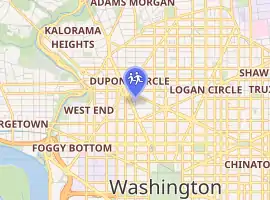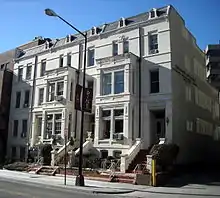Emerson Preparatory School
Emerson Preparatory School (also known as Emerson) is a small private high school in Northwest Washington, D.C., founded in 1852 as the Emerson Institute. It is Washington's oldest co-ed college preparatory school.
| Emerson Preparatory School | |
|---|---|
| Location | |

| |
United States | |
| Information | |
| Type | Independent College Preparatory School |
| Established | 1852 |
| Head of School | Peri-Anne Chobot |
| Enrollment | 55-75 (grades 9-12) |
| Campus | Urban |
| Color(s) | Burgundy and Gold |
| Mascot | Owl |
| Website | www |
Following World War II, Emerson adopted its current academic program providing classes on a term system in which classes are completed in full during each 4 1⁄2-month term. Following graduation, 95% of graduates attend a four-year college and 5% attend a two-year college or take a gap year before attending college. The school serves high school students from Maryland, DC, Virginia, and international communities.
The school is currently located inside the Clocktower Building in Dupont Circle. Emerson has occupied its present location since 2019, after moving from a temporary location in the Twelfth Street YMCA Building. Before 2017, Emerson spent eighty years in their own building across from the American Enterprise Institute. Most students use WMATA to get to and from school.
Emerson Preparatory School is a member of the Association of Independent Maryland and DC Schools (AIMS).
History
Emerson was founded in the District of Columbia in 1852 by Charles Bedford Young, Ph.D., as a school to prepare Washington area boys for entrance to Harvard. It was named for George Barrell Emerson, a noted New England educator, author, and Harvard graduate. After the Civil War the school's graduates began to attend other colleges and universities, and, in 1920, Emerson became Washington's first coeducational preparatory school.
Emerson's school seal features an image of the U.S. Capitol dome and the date 1852. The school mascot is the owl, symbolizing wisdom.
Notable Alumni
- Brian Baker (1983), guitarist and founding member of Minor Threat[1]
- James M. Cutts (c. 1854), Medal of Honor recipient[1]
- Kate Grinold (2003), Miss District of Columbia 2008 and Miss America 2009 finalist[1]
- William F. Gibson (1970), noted science fiction writer and "noir-prophet" of cyberpunk[1]
- Jesse Root Grant, youngest son of Ulysses S. Grant (attended)[1]
- Ulysses S. Grant Jr., second son of Ulysses S. Grant (attended)[1]
- Evan Johns (1974), Grammy nominated rockabilly guitarist
- Jared Leto (1989), Academy Award winning actor and vocalist of the alternative rock band 30 Seconds To Mars[1][2]
- Bruce Magruder, U.S. Army major general[3]
- John Sirica, United States District Judge famous for role in Watergate (attended)[1]
- Cat Marnell, socialite and writer
Academics and faculty
Emerson's model places strong emphasis on small class sizes, typically never larger than ten students,[4] and the use of the term system. The school requires student applicants to submit three letters of recommendation, participate in a personal interview, and take two placement exams, one in English and one in mathematics.
The school's academic year is modeled after the British System and has two terms per year rather than two semesters. Courses are completed in full during each 4 1⁄2-month term. Each term's schedule of classes includes four ninety-minute class periods per day, five days per week. There is a one-hour lunch period, from 11:20 a.m. to 12:20 p.m. Students are allowed to leave the school grounds in order to purchase their lunch from the many restaurants located in the Dupont Circle area.
In the average year, Emerson has approximately ten to fifteen teachers. A typical classload for an instructor is two to three 90-minute classes per day. Apart from the traditional curriculum, private tutorials can be arranged for advanced level courses.
Emerson draws many of its teachers from among the disciplines in which they actually work: it is not unusual for scientists, writers, economists, language scholars, lawyers, and historians to work as teachers. Some Emerson teachers are mid-career in their fields, others are retired, while others are early-career, or in the final stages of their masters' or doctorate degree programs.
Many teachers are drawn to Emerson because it gives them the freedom to structure creative curricula, design unique and advanced level courses, and set their own classroom rules. Some Emerson classes are run strictly while others are more relaxed. Examples include one instructor incorporating periods of relaxation and meditation techniques into ongoing lessons, while another has been known to assign as many as sixteen books in a single term, in a level of rigor comparable to advanced undergraduate work. Students select all of their classes before a term begins.
Recent Emerson course offerings have included:[5]
- American Lit: Misfits and Outsiders
- Minority Voices in American Literature
- Personal Finance
- Topics in STEAM
- Western and Non-Western Medicine
- Genetics
- Web Coding
- American Cultural Studies
- Great Ideas in Western Politics
- Gender Studies
- Civil Law and Legal Reasoning
- Digital Art
- Scientific Illustration
- Advanced Music Theory/Performance
- Algebra 2 Honors
Many classes are requested by students, or designed by teachers on the basis of discussions and interests revealed by faculty and students in a previous term. Students sometimes participate in the planning of a class, although final course selections are determined by the Head of School in accordance with the overall needs of the student body during a given term.
Emerson's daily ninety-minute class periods provide teachers with time to structure their classes to include more discussion, in-depth individual or teamwork, and extended lessons in a single day. Many teachers use the extra time for multimedia presentations like movies or music relevant to the course.
Field trips are an integral part of the Emerson program. Classes take numerous field trips throughout the city each term.
Student body
Emerson has a diverse student population, with students as young as 10 and as old as 20 years old, as well as students from all parts of the world. The Emerson environment is casual and friendly. It is not uncommon for students to leave larger schools because of social or academic issues, come to Emerson, feel comfortable, and quickly find themselves able to manage what was too hard or overwhelming before. Emerson often admits many teenagers who have struggled in other school settings, when the admissions team is confident that the student will be able to succeed in the very nurturing and manageable Emerson environment.
A student must earn a minimum of 24 units of credit to graduate from Emerson Preparatory School. Emerson is a tuition based school. The current full time tuition is $29,000 per school year. Students graduate within three years and over 95% of them go straight on to college. Other graduates take a gap year following graduation in order to pursue other interests before enrolling in college. Emerson has a limited number of formal scholarships available each year. Emerson admits students from a wide variety of racial, ethnic, religious, and economic backgrounds.
During its early history, Emerson had sports and drama[6] teams when it was first founded and later under the direction of Dean John J. Humphrey, the school's headmaster from 1939–1999. However, Emerson's main focus and strength since the 1940s has been on academics and preparing students for college level work. Emerson has had a diverse offering of student clubs throughout the years.
Locations

Emerson first opened at 914 14th Street Northwest Washington DC near Franklin Square between K and I Streets. In 1928, Emerson moved to a new building at 1740 P Street NW between Massachusetts and New Hampshire Avenues. In 1933, Emerson moved to 1525 16th Street NW near Stead Park between Q and Church Streets. In 1937, Emerson moved to 1324 18th Street NW near Dupont Circle between Massachusetts and Connecticut Avenues. In 2017, Emerson moved to a temporary location, the fourth floor of the Thurgood Marshall Center for Service and Heritage. Emerson has occupied its present location, the fourth Floor of the Clocktower Building in Dupont Circle (1718 Connecticut Avenue NW) since 2019.[7]
References
- "Notable Emerson Graduates". Emerson Prep.org. Washington, DC: Emerson Preparatory School Alumni Association. Retrieved August 28, 2020.
- "The Battles of Our Youth". Into the Wild. 1 March 2015. VyRT.
- "College Cadets Salute Magruder for Last Time". The News & Observer. Raleigh, NC. May 27, 1936. p. 16 – via Newspapers.com.
- "Emerson at D.C. Local School Directory". Retrieved 2007-02-12.
- "Course Offerings". EmersonPrep.org. Washington, DC: Emerson Preparatory School. Retrieved January 11, 2021.
- "Emerson Institute Dramatic Club at Washington Post Archives". 1895-05-14. Retrieved 2007-02-01.
- "Vibrant Location". EmersonPrep.org. Washington, DC: Emerson Preparatory School. Retrieved January 11, 2021.
External links
| Wikimedia Commons has media related to Emerson Preparatory School. |
- Emerson Preparatory School official website



